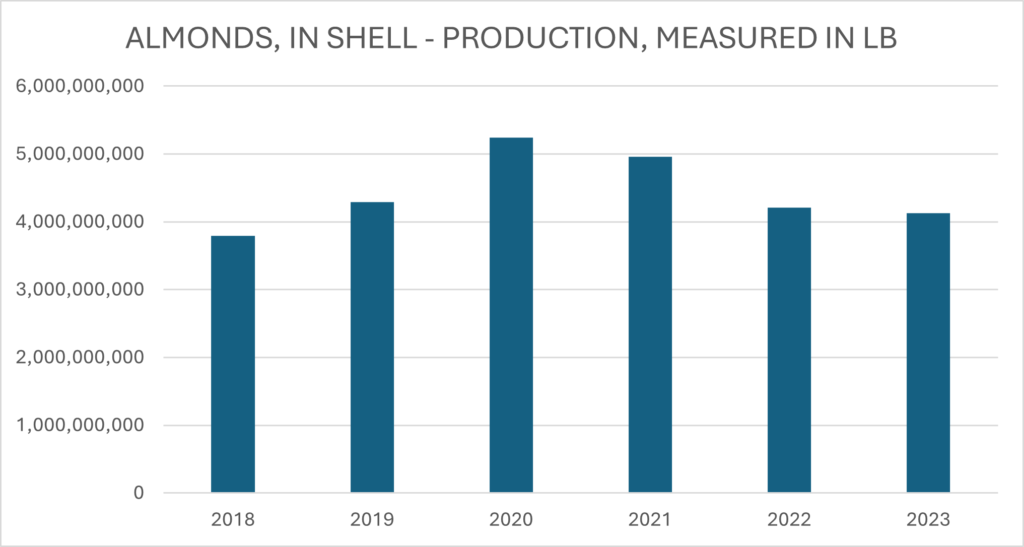Tree nuts are important food commodities that are an excellent energy source and dietary protein that are rich in natural bioactive and health-promoting compounds. The major tree nuts include almonds, pistachio nuts, and walnuts. These nuts are a major source of protein and energy. In recent years, the popularity of tree nuts has grown dramatically after epidemiological studies and clinical intervention trials discovered an inverse relationship between tree nut consumption and chronic diseases.
In the last two years, the U.S. and Turkey were the world's largest producers of tree nuts, producing more than 200 thousand tons. In comparison, the biggest consumer-importers of tree nuts was China.
Forecast – Almonds
The 2023 almond bloom was unique and less successful due to low temperatures, wet weather, and stormy conditions. This led to delayed pesticide treatments and reduced bee flight hours.
The California Almond Objective Measurement Report suggested slightly lower yields in 2023 (1,880 pounds per acre) than in 2022 (1,900 pounds per acre). If realized, 2023's yields would be the weakest since 2009.

Source- https://quickstats.nass.usda.gov/results/33DD749E-7788-3D8F-9DDF-B38C1E6CA91D
In 2024, almond bloom progressed more quickly, with peak bloom occurring for some varieties before March. February 2024 had fewer wet, windy days than in 2023, but excellent weather in late February increased bee activity. California experienced one of its driest periods on record during 2022 and early 2023. Drought is not expected to be a problem in 2023/24. With improved pollination and drought conditions, almond yields are expected to rebound and may exceed the historical average in 2024.
Forecast- Pistachio
The U.S. pistachio crop for the 2023/24 season is expected to reach a record 1.5 billion pounds (in-shell), according to data from the Administrative Committee for Pistachios (ACP). This is nearly 70% higher than last season's production and 29% higher than the previous record in 2021/22. California pistachio orchards have experienced adequate chill hours and water availability, with nearly 30,000 more bearing acres compared to last season. Pistachio acreage has increased five-fold in two decades, surpassing walnuts in 2021/22 to rank second in California tree nut-bearing acres. ACP estimated approximately 461,000 bearing acres, 144,000 non-bearing acres, and 10,500 newly planted acres in California in 2023.

Source - https://quickstats.nass.usda.gov/results/EA75BB94-3006-3116-BDD1-6A8EA6E4AA23
The average yield of 3,217 pounds per acre in 2023 was up 56 percent from the previous year and 14% from 2021. However, the preliminary estimate does not crack the top five historically high annual yields. Beginning stocks for the 2023/24 season are less than half of beginning stocks for 2022/23. A smaller 2022/23 crop, coupled with strong domestic and international demand, helped reduce inventories.
U.S. export volume of in-shell pistachios in the first 5 months of the 2023/24 season totalled 423.6 million pounds, 73% higher than the second-highest volume for that period (244.2 million pounds in 2021/22). China accounted for the largest share with 41% of export volume (175.8 million pounds), up 230%from the previous season. Lower prices contributed to the strong start to the 2023/24 pistachio export season.
Forecast- Walnut
Walnut, also known as Juglans regia, is a popular and nutritious tree nut in the United States. The deciduous tree is known for its timber and the walnut kernel, which is rich in omega-3 fatty acids essential for brain health and cardiovascular well-being. Walnuts are also a good source of protein, fiber, vitamins, and minerals, making them a cherished ingredient in various cuisines worldwide.

Source- USDA/NASS QuickStats Ad-hoc Query Tool
Walnut yields in 2023 were 2.03 tons per acre, 5% higher than the 10-year average. Walnuts in California have high chill requirements, with some cultivars requiring 700-1,000 chill hours per year. Cold weather in 2023 met these requirements. However, the milder winter of 2024 led to a 50% decrease in chill hours from November 1 to February 29. While it remains uncertain whether this decrease will significantly affect yields, walnut yields in 2024 are expected to decrease relative to 2023.
